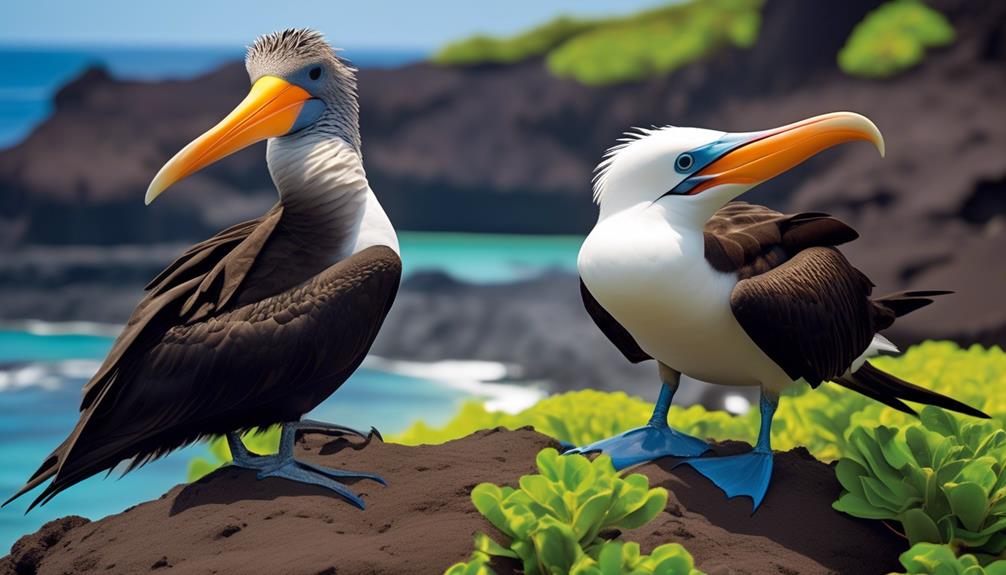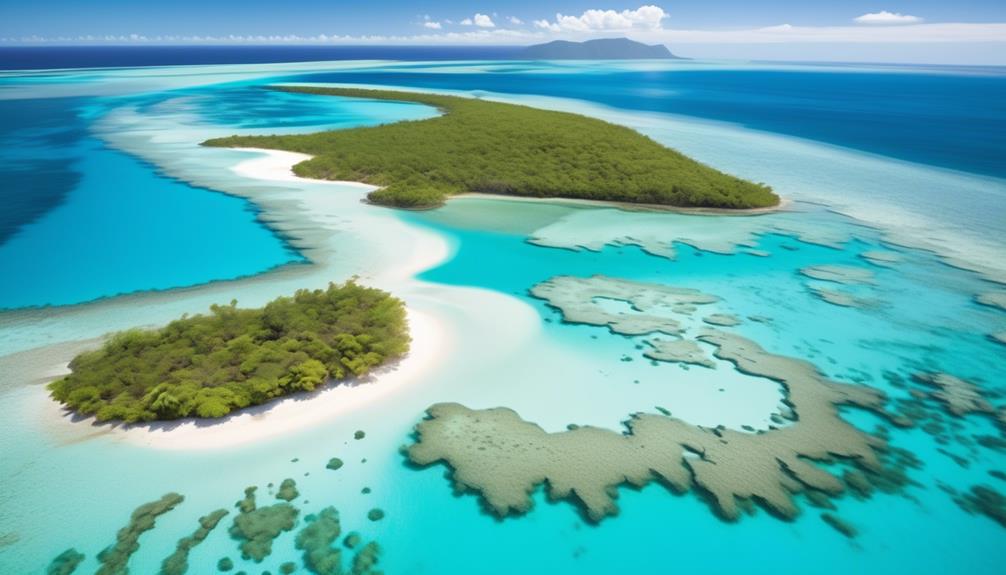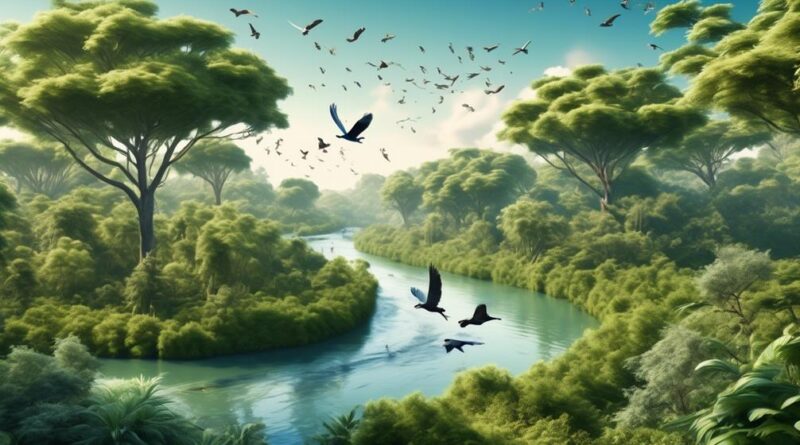What Are the Best Remote Birdwatching Sanctuaries?
Have you ever wondered where you can find the most remote and stunning birdwatching sanctuaries in the world?
There's a theory that the best birdwatching experiences are often found in the most remote and untouched places. But how do you determine which sanctuaries truly offer the most exceptional opportunities for birdwatching?
The answer lies in exploring some of the most remote and breathtaking locations on the planet, where diverse avian species thrive in their natural habitats.
These sanctuaries not only provide a haven for birdlife but also offer a chance for you to immerse yourself in the beauty of unspoiled nature.
Galapagos Islands

When visiting the Galapagos Islands for birdwatching, be sure to explore the diverse habitats that support a wide variety of avian species. The islands are a haven for wildlife conservation, with numerous efforts in place to protect the unique species that call this archipelago home. As an ecotourism enthusiast, you'll be delighted to know that the Galapagos Islands offer exceptional opportunities to witness wildlife conservation in action while enjoying the beauty of these remote birdwatching sanctuaries.
The Galapagos Islands boast an impressive array of bird species, many of which are found nowhere else on Earth. From the iconic blue-footed booby to the magnificent frigatebird, the islands provide a rare chance to observe these creatures up close in their natural habitat. As you embark on your birdwatching adventure, you'll witness firsthand the efforts being made to ensure the preservation of these remarkable avian species.
In addition to the breathtaking wildlife, the Galapagos Islands also offer unparalleled ecotourism opportunities. By participating in responsible, sustainable tourism practices, you can contribute to the ongoing conservation efforts while experiencing the natural wonders of the islands. Whether you're exploring the volcanic landscapes or observing the diverse birdlife, your visit supports the local economy and conservation initiatives, making a positive impact on the delicate ecosystem of the Galapagos Islands.
Maasai Mara
Explore the vast savannah of Maasai Mara to witness an extraordinary array of wildlife in their natural habitat. The Maasai Mara National Reserve in Kenya is renowned for the annual Maasai Mara migration, where millions of wildebeest, zebras, and gazelles move across the plains in search of greener pastures, creating one of the most spectacular wildlife displays on the planet. The migration occurs from July to October, offering an unparalleled opportunity to witness this awe-inspiring natural phenomenon.
Maasai Mara isn't only a site of extraordinary natural events but also a focal point for conservation efforts. The Maasai Mara ecosystem faces various conservation challenges due to human-wildlife conflict, habitat destruction, and poaching. However, concerted Maasai Mara conservation efforts have been implemented to protect this vital ecosystem. Conservation organizations, local communities, and government authorities are working together to safeguard the wildlife and habitats within Maasai Mara. These initiatives include community-based conservation programs, anti-poaching patrols, and sustainable tourism practices aimed at preserving the ecological balance of the reserve.
When visiting Maasai Mara, you play a crucial role in supporting these conservation endeavors. By practicing responsible tourism, respecting the wildlife, and supporting local conservation initiatives, you contribute to the preservation of this unique natural heritage. As you immerse yourself in the breathtaking landscapes and diverse wildlife of Maasai Mara, remember that your presence can have a positive impact on the future of this iconic wilderness.
Great Barrier Reef

Stretching over 2,300 kilometers, the Great Barrier Reef is the world's largest coral reef system. As you explore this magnificent underwater world, you'll encounter a diverse array of marine life and vibrant coral formations.
Here's what you can expect to experience at this iconic remote birdwatching sanctuary:
- Marine Biodiversity: The Great Barrier Reef is home to an astonishing variety of marine species. As you snorkel or dive, you'll encounter colorful fish, sea turtles, sharks, and an abundance of other fascinating creatures. The reef's crystal-clear waters offer a window into a mesmerizing underwater ecosystem.
- Coral Bleaching: Unfortunately, the reef has faced significant challenges due to coral bleaching, a result of rising ocean temperatures. This has led to the loss of vibrant colors and vital habitats for marine life. Conservation efforts are underway to mitigate the impact and restore the reef's health.
- Ecological Impact: The ecological significance of the Great Barrier Reef can't be overstated. It supports a complex web of life and plays a crucial role in ocean health. Understanding the ecological impact of human activities on the reef underscores the importance of sustainable practices and conservation initiatives.
As you immerse yourself in the beauty of the Great Barrier Reef, keep in mind the delicate balance that sustains this remarkable ecosystem. Through responsible tourism and continued conservation efforts, we can work towards preserving this natural wonder for future generations.
Pantanal Wetlands
Nestled within the heart of South America, the Pantanal Wetlands teem with an incredible diversity of wildlife and offer a unique opportunity for immersive birdwatching experiences.
Spanning over 75,000 square miles across Brazil, Bolivia, and Paraguay, the Pantanal is the world's largest tropical wetland area, making it a haven for birdwatchers and wildlife enthusiasts alike.
The region boasts an astonishing array of bird species, with over 650 varieties calling this wetland home. From the majestic jabiru stork to the vibrantly colored hyacinth macaw, the Pantanal provides unparalleled birdwatching opportunities.
In addition to its impressive avian population, the Pantanal Wetlands are also at the forefront of wildlife conservation efforts. The area is home to iconic species such as the jaguar, giant river otter, and tapir.
Conservation initiatives in the Pantanal focus not only on protecting these charismatic megafauna but also on preserving the delicate balance of the wetland ecosystem. Sustainable tourism and responsible birdwatching practices play a crucial role in supporting these conservation endeavors, allowing visitors to witness the beauty of the Pantanal while minimizing their impact on the environment.
Whether you're a seasoned birder or a nature enthusiast seeking an unforgettable wildlife experience, the Pantanal Wetlands offer an unparalleled opportunity to immerse yourself in the diverse and captivating world of birdwatching while contributing to vital wildlife conservation efforts.
Danube Delta

The Danube Delta, located in Eastern Europe, is a sprawling wetland renowned for its rich biodiversity and vibrant birdwatching opportunities. If you're a birdwatching enthusiast or a wildlife photography aficionado, the Danube Delta is a must-visit destination. Here's what you can expect when you explore this remarkable sanctuary:
- Birdwatching Tours: Join guided birdwatching tours led by knowledgeable local experts. These tours offer an immersive experience, allowing you to observe an incredible variety of bird species in their natural habitat.
- Wildlife Photography Opportunities: The Danube Delta provides a stunning backdrop for capturing striking images of diverse bird species, as well as other wildlife such as wild horses and water buffalo. Whether you're an amateur photographer or a seasoned pro, the Delta's natural beauty will inspire your creativity.
- Boat Excursions: Embark on boat excursions that take you through the intricate network of waterways, providing unparalleled access to the heart of the Delta. This allows for exceptional birdwatching and photography opportunities, especially during the early morning and sunset hours.
- Accommodation in Nature Reserves: Stay in accommodations nestled within the Delta's nature reserves for an immersive experience. Wake up to the sounds of diverse bird calls and immerse yourself in the tranquility of this unique environment.
Visiting the Danube Delta offers a chance to witness an abundance of avian life and capture breathtaking moments through your lens. Whether you're seeking birdwatching adventures or aiming to capture stunning wildlife images, the Delta promises an unforgettable experience.
Raja Ampat
If you're craving a new birdwatching adventure after exploring the Danube Delta, consider venturing to the breathtaking Raja Ampat, an Indonesian archipelago renowned for its stunning marine biodiversity and avian treasures.
Raja Ampat, located off the northwest tip of the island of New Guinea, is a haven for birdwatchers and nature enthusiasts alike. The region's marine biodiversity is unparalleled, with over 1,500 fish species and 75% of the world's known coral species found in its waters. The lush forests and pristine beaches of Raja Ampat provide an ideal habitat for a diverse range of bird species, making it a paradise for birdwatching.
Raja Ampat's coral reefs are a sight to behold, teeming with vibrant marine life and offering unparalleled opportunities for snorkeling and diving. As you explore the crystal-clear waters, you'll encounter a kaleidoscope of fish, sea turtles, and other fascinating creatures, creating an unforgettable birdwatching and marine adventure. Keep an eye out for the magnificent birds of paradise, which are indigenous to the region and known for their dazzling plumage and elaborate courtship displays.
In addition to its natural beauty, Raja Ampat is also committed to conservation efforts, ensuring that its ecosystems remain pristine and its wildlife protected. By visiting this remote sanctuary, you not only have the chance to witness its awe-inspiring marine biodiversity and stunning coral reefs but also contribute to the preservation of this ecological gem.
Raja Ampat promises an unparalleled birdwatching experience amidst a backdrop of unparalleled natural beauty and marine wonders.
Kakadu National Park

Consider venturing to Kakadu National Park, an Australian treasure renowned for its diverse wildlife and ancient Aboriginal rock art. When it comes to remote birdwatching sanctuaries, Kakadu National Park offers a truly unique and immersive experience. Here's what you can expect:
- Kakadu wildlife: Kakadu National Park is home to an incredible array of bird species, including colorful parrots, majestic birds of prey, and unique waterbirds. The diverse habitats within the park, including wetlands, woodlands, and floodplains, provide a haven for both migratory and resident bird species.
- Remote birdwatching: In Kakadu, you'll have the opportunity to explore remote and untouched landscapes, allowing for uninterrupted birdwatching experiences. The park's vast size and varied ecosystems mean that you can discover secluded spots to observe birds in their natural habitats without the presence of crowds.
- Aboriginal rock art: While birdwatching, take the time to appreciate the ancient Aboriginal rock art sites scattered throughout the park. These artworks provide a fascinating glimpse into the cultural and spiritual significance of birds to the traditional owners of the land.
- Guided tours and resources: Kakadu National Park offers guided birdwatching tours and resources, including informative visitor centers and knowledgeable rangers who can enhance your birdwatching adventures with their insights into the park's avian inhabitants.
Immerse yourself in the wonders of Kakadu National Park, where remote birdwatching and the rich diversity of wildlife combine to create an unforgettable experience.
Queen Elizabeth National Park
Venture to Queen Elizabeth National Park, an East African gem teeming with diverse wildlife and stunning landscapes. The park, located in Uganda, is a haven for wildlife conservation, providing a safe habitat for a wide array of species. As you explore the park, you'll be captivated by the sight of elephants, lions, leopards, and a vast number of bird species. Queen Elizabeth National Park offers remarkable ecotourism opportunities, allowing you to immerse yourself in the beauty of nature while contributing to its preservation.
The park's dedicated efforts to wildlife conservation are evident in its successful conservation programs, aimed at protecting endangered species and preserving their natural habitats. By visiting Queen Elizabeth National Park, you actively support these conservation initiatives, making a meaningful contribution to the protection of East Africa's precious wildlife. As you embark on game drives or boat safaris, you'll witness the conservation efforts firsthand, gaining a deeper appreciation for the park's commitment to preserving its natural heritage.
Furthermore, Queen Elizabeth National Park offers remarkable ecotourism opportunities, allowing you to experience the park's natural wonders while promoting sustainable travel practices. Whether you're observing the diverse birdlife, cruising along the Kazinga Channel, or embarking on a guided nature walk, you'll be contributing to the local economy and the conservation of this remarkable ecosystem.
Your visit to Queen Elizabeth National Park not only grants you the chance to witness unparalleled wildlife spectacles but also enables you to play a vital role in safeguarding this biodiverse sanctuary for future generations.
Frequently Asked Questions
Are These Sanctuaries Accessible for People With Disabilities?
Yes, these sanctuaries are accessible for people with disabilities. They have inclusive facilities to address accessibility challenges. You'll find ample birdwatching opportunities and a diverse range of bird species to observe and enjoy.
What Are the Best Times of Year to Visit These Sanctuaries for Birdwatching?
For the best birdwatching, consider bird migration and seasonal patterns. Visit during peak migration times for an abundance of bird activity. Check the weather conditions, as they can impact bird behavior and visibility.
Are There Any Specific Bird Species That Are Only Found in These Sanctuaries?
You'll find unique bird species in these remote sanctuaries due to conservation efforts and habitat preservation. Endangered birds often rely on these areas for survival, making them important for both birdwatching and conservation efforts.
What Accommodations Are Available for Visitors at Each of These Sanctuaries?
When you visit these remote birdwatching sanctuaries, you'll find a range of accommodation options, from cozy cabins to tent camping. Visitor amenities include guided tours, birdwatching activities, and a strong focus on environmental conservation efforts.
Are There Any Specific Guidelines or Regulations for Birdwatching in These Sanctuaries?
When birdwatching remotely, it's important to follow birdwatching etiquette and be mindful of your environmental impact. Bird migration and conservation efforts are key considerations, so familiarize yourself with sanctuary guidelines and regulations.
Conclusion
So, whether you're an avid birdwatcher or just looking to experience the beauty of nature from a distance, these remote birdwatching sanctuaries offer incredible opportunities to observe a wide variety of bird species in their natural habitats.
From the unique wildlife of the Galapagos Islands to the stunning landscapes of Kakadu National Park, there's no shortage of amazing birdwatching experiences to be had.
So grab your binoculars and start planning your next remote birdwatching adventure!
